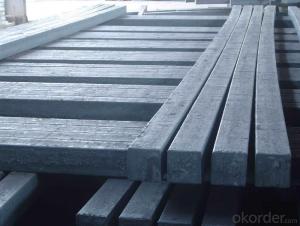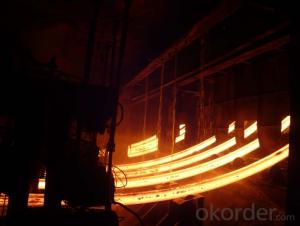Square Steel Billet Q235 3SP Grade Prime Quality 1#
- Loading Port:
- Tianjin
- Payment Terms:
- TT OR LC
- Min Order Qty:
- 2000 m.t
- Supply Capability:
- 50000 m.t/month
OKorder Service Pledge
OKorder Financial Service
You Might Also Like
Description of Square Steel Billet Q235 3SP Grade Prime Quality 1#
M. S. Billets are used for rolling of TMT Re-Bars of Fe415 and Fe500 Grade and various other structural steel products.
CRS Billets are used for rolling of CRS TMT Re-Bars.
Special Alloy Billets are used for rolling of any special grade TMT Re-Bars like Earthquake resistant TMT Re-Bars and for special grade structural steel products.
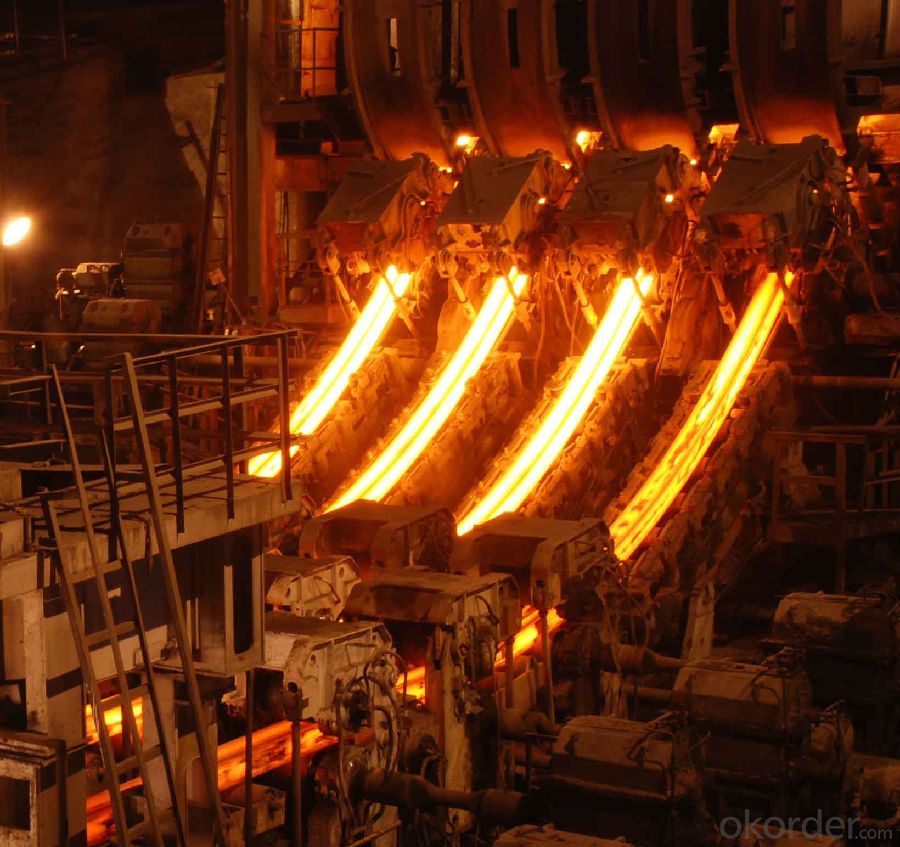
Main Feature Square Steel Billet Q235 3SP Grade Prime Quality 1#
Raw elements(C,Fe,Ni,Mn,Cr,Cu.)---Smelted ingots by AOD finery---hot rolled into black suface---pickling in acid liquid---cold drawn----polished by automatically machine--- cutting into pieces---checking quanlity
Applications of Square Steel Billet Q235 3SP Grade Prime Quality 1#
Widely Used in the areas such as Stainless Steel Fasteners, Chains, Kitchen and Sanitary wares, Furniture handles, Handrails, Electroplating and Electrolyzing pendants, Foods, Electron, Petroleum, Construction and Decoration, etc. Products have a high strength after cold-working. Electronic products parts, Medical appliance, Springs, Bus Inside and Outside packaging and building, Street Lamp Posts, etc. Decoration materials and Outdoor Publicity Billboard. Used for the products which have the Anti-Stress Corrosion requirement. Electron Products, Table-wares, Bolts, Nuts, Screen Meshes, Cumbustors and so on.
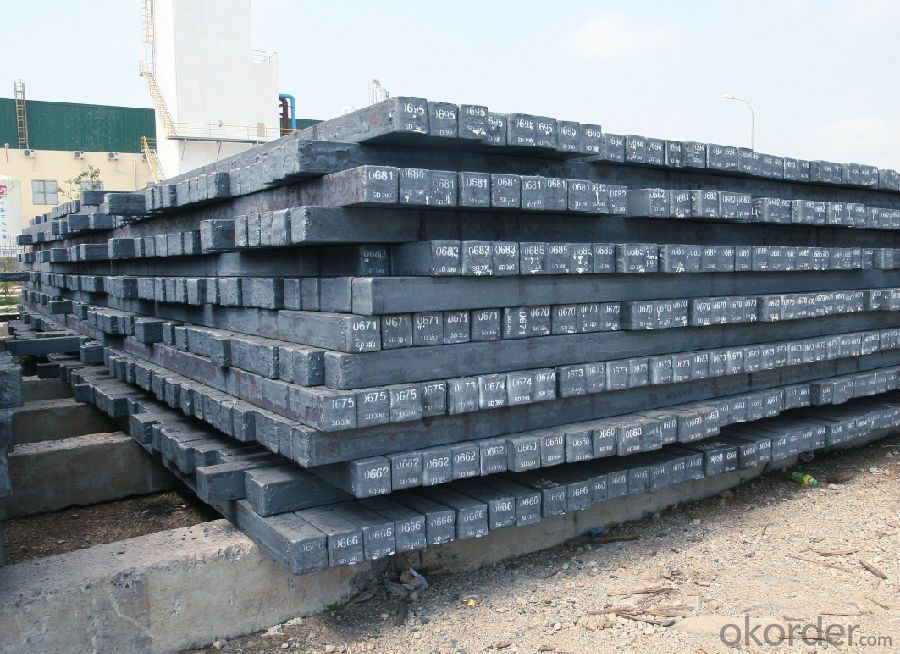
Specifications of Square Steel Billet Q235 3SP Grade Prime Quality 1#
| Standard | C(%) | Mn(%) | S(%) | P(%) | Si(%) |
| Q195 | ≤0.12 | ≤0.50 | ≤0.040 | ≤0.035 | ≤0.30 |
| Q235 | ≤0.20 | ≤1.40 | ≤0.045 | ≤0.045 | ≤0.35 |
| Q275 | ≤0.22 | ≤1.50 | ≤0.045 | ≤0.045 | ≤0.35 |
| 20MnSi | 0.17-0.25 | 1.2-1.6 | ≤ 0.050 | ≤ 0.050 | 0.40-0.80 |
| 3SP | 0.14-0.22 | 0.40-0.85 | ≤ 0.050 | ≤ 0.040 | 0.05-0.15 |
| 5SP | 0.28-0.37 | 0.50-1.00 | ≤ 0.050 | ≤ 0.040 | 0.15-0.30 |
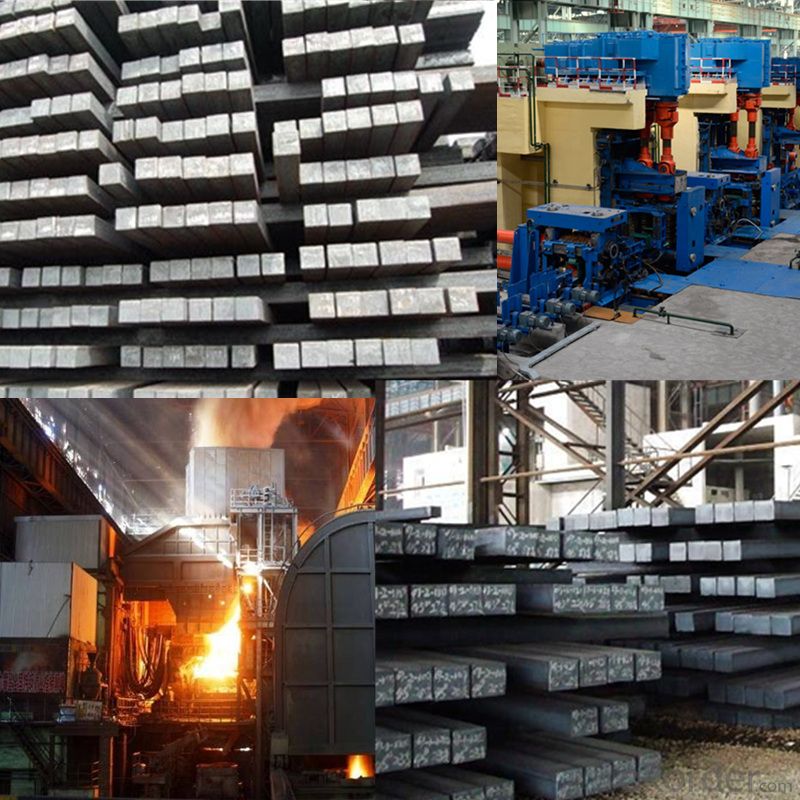
FAQ of Square Steel Billet Q235 3SP Grade Prime Quality 1#
We have organized several common questions for our clients,may help you sincerely:
1. How Can I Visit There?
Our company is located in Tianjin City, China, near Beijing. You can fly to Tianjin Airport Directly. All our clients, from home or aboard, are warmly welcome to visit us!
2. How Can I Get Some Sample?
We are honored to offer you sample.
3. Why choose CNBM?
Our delivery time about 15-20days for standard sizes, if you have other requirements like hardness, quanity and width ,it is about 20-40days. But don't worry we also try our best for the delivery time ,because time longer and our cost is higher.
- Q:What are the different types of steel billet packaging?
- There are several types of steel billet packaging, including wooden crates, steel or plastic wrapping, and steel wire or strapping.
- Q:What are the different shapes and sizes of steel billets?
- Steel billets are found in various shapes and sizes depending on their intended use and manufacturing method. The most frequently seen shapes of steel billets include square, rectangular, and round. Square billets are commonly employed in forging and rolling processes where they are heated and molded into different products like bars, rods, and rails. These billets have equal dimensions on all sides, creating a square shape. On the other hand, rectangular billets have longer sides and shorter ends, resembling a rectangular shape. They are often utilized in the production of structural components such as beams and columns, as well as for creating pipes and tubes. As the name implies, round billets have a cylindrical shape and are frequently used in the manufacturing of seamless pipes, axles, and shafts. Their uniform circular cross-section makes them suitable for processes involving rotary motion or requiring a strong cylindrical shape. In terms of size, steel billets can vary significantly depending on the specific requirements of the final product. Factors such as the desired end product, manufacturing process, and available equipment determine their dimensions. Common sizes range from small billets measuring approximately 100mm to 200mm in diameter or width, to larger billets exceeding 300mm in diameter or width. It is worth noting that steel billets can also be customized to meet the specific size and shape requirements of different industries. This versatility allows for the production of a wide range of steel products, serving diverse applications in the construction, automotive, and other manufacturing sectors.
- Q:What are the common sizes and dimensions of steel billets?
- The common sizes and dimensions of steel billets vary widely depending on the specific industry and application. However, some common dimensions include square shapes ranging from 100x100mm to 300x300mm and rectangular shapes with dimensions of 200x300mm to 400x600mm. Additionally, cylindrical billets typically have diameters ranging from 100mm to 300mm. It is important to note that these dimensions can differ significantly based on the requirements of the end-use industry.
- Q:What are the different types of steel billet defect detection methods?
- The industry commonly utilizes various steel billet defect detection methods to ensure the production of high-quality products. These methods help identify defects or imperfections in the steel billets. Some of the methods include: 1. Visual Inspection: Trained inspectors visually examine the billets for visible defects, such as cracks, surface irregularities, or deformations. While effective for certain defects, internal or hidden defects may go undetected. 2. Ultrasonic Testing: High-frequency sound waves are used to detect defects within the billets. Any disruptions in the waves indicate the presence of defects like cracks or voids. This technique is widely used for detecting internal defects. 3. Magnetic Particle Inspection: The steel billet is magnetized, and iron particles are applied. If there are surface or near-surface defects, the particles are attracted to these areas, making the defects visible. This method is useful for detecting surface cracks and discontinuities. 4. Eddy Current Testing: Electromagnetic induction is utilized to detect surface or near-surface defects. By placing a coil carrying an alternating current near the billet, changes in electrical conductivity or magnetic properties caused by defects are detected. Eddy current testing is particularly effective for detecting surface cracks and corrosion. 5. X-ray Testing: X-ray radiation is passed through the steel billet, and the resulting image is captured on a film or digital detector. Dark spots on the X-ray image indicate internal defects like cracks, voids, or inclusions. This method is highly effective for detecting internal defects. 6. Laser Scanning: A laser scanner is used to create a three-dimensional image of the steel billet's surface. Specialized software is employed to detect and analyze any irregularities or deformations in the surface. Laser scanning is a precise and efficient method for detecting surface defects. These are just a few of the steel billet defect detection methods commonly used in the industry. Each method has its own advantages and limitations, and the choice depends on factors like the type of defect, billet size and shape, and required precision. Employing these methods ensures the production of high-quality steel products.
- Q:How do steel billets contribute to energy efficiency?
- Steel billets contribute to energy efficiency in several ways: 1. Production efficiency: Steel billets are the initial form of steel that is used in various manufacturing processes. By using steel billets as a starting material, manufacturers can achieve greater production efficiency. The uniform size and shape of billets allow for easier handling, cutting, and shaping, reducing energy consumption during the manufacturing process. 2. Resource optimization: Steel billets are typically made from recycled steel scrap. By using recycled steel as the raw material, manufacturers reduce the need for extracting and processing virgin iron ore, which is an energy-intensive process. This helps in conserving natural resources and reducing the overall energy consumption associated with steel production. 3. Heat recovery: During the manufacturing of steel billets, high temperatures are required to melt and shape the steel. However, modern steel plants are equipped with advanced technologies that allow for efficient heat recovery. The excess heat generated during the process can be captured and utilized for various purposes, such as generating steam or heating other areas of the plant. This heat recovery system helps to reduce energy wastage and increase overall energy efficiency. 4. Energy-efficient equipment: Steel billet production often involves the use of heavy machinery and equipment. Manufacturers are increasingly investing in energy-efficient technologies and equipment to reduce energy consumption. For example, using more efficient electric arc furnaces or induction heating systems can significantly reduce energy requirements compared to traditional methods. These advancements in technology contribute to the overall energy efficiency of steel billet production. Overall, steel billets play a crucial role in energy efficiency within the steel industry. From production efficiency to resource optimization and heat recovery, the use of steel billets helps in minimizing energy consumption and promoting a more sustainable steel manufacturing process.
- Q:What are the different types of steel billet rolling defects?
- During the rolling process, various defects can arise in steel billets, which can have adverse effects on the final product's quality and integrity. The most commonly encountered types of steel billet rolling defects are as follows: 1. Surface cracks: These are minute cracks that manifest on the billet's surface. They can result from inadequate cooling or excessive rolling pressure. Surface cracks jeopardize the steel's strength and durability. 2. Center cracks: Inner core cracks occur when temperature control during the rolling process is incorrect. Center cracks can lead to structural weaknesses and reduced steel performance. 3. Scalloping: Scalloping refers to the formation of shallow depressions or grooves on the billet's surface. It usually arises due to uneven or improper rolling pressure distribution. Scalloping negatively impacts the steel's appearance and surface quality. 4. Lamination: Lamination defects involve the separation of layers within the billet. They can be caused by the presence of impurities or inclusions in the steel, as well as inadequate heating or rolling conditions. Lamination defects weaken the steel and increase the risk of failure. 5. Wavy edges: Wavy edges occur when the billet's edges become uneven or distorted during rolling. This can be the result of improper alignment or uneven pressure distribution. Wavy edges affect the steel's dimensional accuracy and overall quality. 6. Surface defects: Surface defects encompass scratches, pits, or other imperfections on the billet's surface. They may occur due to insufficient cleaning or handling procedures, as well as improper rolling conditions. Surface defects impact the steel's appearance and surface quality. In conclusion, these steel billet rolling defects hold significant implications for the final product's quality, performance, and safety. Manufacturers must closely monitor the rolling process and implement appropriate quality control measures to minimize the occurrence of these defects.
- Q:How are steel billets used in the production of agricultural implements?
- Steel billets are used in the production of agricultural implements by being further processed and shaped into various components such as plowshares, tillage tools, and blades. These billets serve as the raw material from which these implements are manufactured, providing the necessary strength, durability, and resistance to withstand the demanding conditions of agricultural operations.
- Q:Can steel billets be used for making sculptures?
- Yes, steel billets can be used for making sculptures. Steel is a versatile material that offers strength, durability, and the ability to be shaped and molded into various forms. Many artists have embraced steel as a medium for creating sculptures due to its modern aesthetic and its ability to withstand outdoor conditions. By heating, cutting, and welding the steel billets, artists can transform them into unique and imaginative sculptures.
- Q:What are the different surface defects found in alloy steel billets?
- Alloy steel billets can exhibit several surface defects that may arise during production, impacting the final product's quality and performance. Some typical defects seen in these billets are as follows: 1. Scale: Scale refers to a thin layer of oxide forming on the billet's surface during heating and cooling. It can occur due to exposure to air or the presence of impurities in the steel. Scale can have adverse effects on the surface finish and lead to corrosion. 2. Cracks: The billet's surface may develop cracks due to various factors, such as improper cooling, excessive stress, or mishandling. These cracks can compromise the billet's structural integrity, potentially resulting in failure during subsequent processing or in the final product. 3. Pits: Pits are small depressions or cavities found on the billet's surface. They can arise from impurities or the steel's reaction with the environment. Pits can impact the surface finish and serve as stress concentration points, leading to further damage or failure. 4. Laminations: Laminations refer to layers or sheets of non-metallic material within the billet. They can occur due to incomplete bonding during production or the presence of impurities in the steel. Laminations can weaken the billet, making it susceptible to failure under load. 5. Inclusions: Inclusions are non-metallic particles or impurities present in the steel. They may be introduced during production or already present in the raw materials. Inclusions can affect the steel's mechanical properties, reducing its strength, toughness, and ductility. 6. Decarburization: Decarburization involves the loss of carbon from the steel's surface. It can happen during the heating process or due to exposure to air. Decarburization can lead to reduced hardness and strength in the affected area. Detecting and addressing these surface defects in alloy steel billets is crucial for ensuring the production of high-quality and reliable products. Various inspection and testing methods, including visual inspection, ultrasonic testing, and magnetic particle inspection, can be employed to identify and assess these defects.
- Q:What are the key factors driving the demand for steel billets?
- The demand for steel billets is influenced by several key factors. Firstly, the construction industry plays a crucial role in driving this demand. Steel is widely utilized in construction projects for various purposes, including structural framing, reinforcement, and support systems. With the continuous growth of urbanization and increasing infrastructure projects, the demand for steel billets also rises. Additionally, the automotive industry significantly impacts the demand for steel billets. Steel is an essential material in the manufacturing of automobiles, such as car bodies, chassis, and engine components. As the global automotive industry expands and consumer demand for vehicles increases, the demand for steel billets also rises accordingly. Moreover, the energy sector contributes to the demand for steel billets, particularly in the production of oil and gas pipelines. Steel billets are used in the manufacturing of seamless pipes, which are vital for the transportation of oil and gas over long distances. As the demand for energy continues to grow, there is a corresponding need for steel billets to support pipeline construction. Furthermore, the manufacturing and machinery industries heavily rely on steel billets. Steel is a fundamental material used in various manufacturing processes, from industrial machinery to consumer products. As these industries grow and evolve, the demand for steel billets remains steady. Lastly, the demand for steel billets is significantly influenced by global economic growth and industrialization in emerging markets. Countries with rapidly developing economies, such as China and India, are major consumers of steel billets as they undergo massive infrastructure projects and industrial expansion. In conclusion, the demand for steel billets is primarily driven by the construction industry, automotive sector, energy sector, manufacturing industry, and global economic growth. These factors collectively contribute to the sustained and growing demand for steel billets in the market.
1. Manufacturer Overview |
|
|---|---|
| Location | |
| Year Established | |
| Annual Output Value | |
| Main Markets | |
| Company Certifications | |
2. Manufacturer Certificates |
|
|---|---|
| a) Certification Name | |
| Range | |
| Reference | |
| Validity Period | |
3. Manufacturer Capability |
|
|---|---|
| a)Trade Capacity | |
| Nearest Port | |
| Export Percentage | |
| No.of Employees in Trade Department | |
| Language Spoken: | |
| b)Factory Information | |
| Factory Size: | |
| No. of Production Lines | |
| Contract Manufacturing | |
| Product Price Range | |
Send your message to us
Square Steel Billet Q235 3SP Grade Prime Quality 1#
- Loading Port:
- Tianjin
- Payment Terms:
- TT OR LC
- Min Order Qty:
- 2000 m.t
- Supply Capability:
- 50000 m.t/month
OKorder Service Pledge
OKorder Financial Service
Similar products
New products
Hot products
Related keywords


